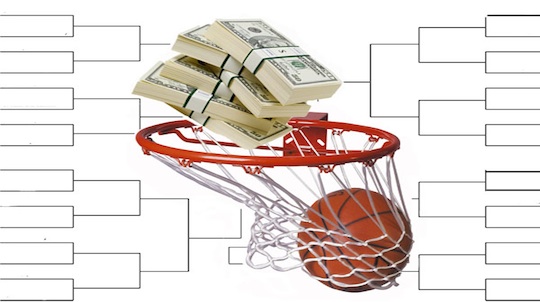
Review of Last Year
This will be the second year that I produce the “Using a DFS Mindset for your March Madness Bracket” series. This article (Part 1) is mostly a recycle of my intro article from last season which helps set the stage for my process when filling out my bracket. Then Part 2 which will come out Tuesday or Wednesday goes through all the numbers and my thoughts on who to pick and why in each round.
My picks last year fared pretty well, especially in the Round of 64 where my selections went 28-4. Other “good” from last year’s picks included having Gonzaga in the Championship game (although I had them winning it), fading Duke and Arizona who were both out before the Elite 8 and some good contrarian large pool suggestions including Wisconsin (who upset 1-Seed Villanova), South Carolina (who made it to the Final 4) and Oregon (who also made it to the Final 4). The “bad” was only getting one Final Four team correct (Gonzaga), a poor Round of 32 (8-8), and way too much belief in Louisville who got bounced early. View last year’s picks article here.
So with that, I will look to improve this year. Here is the overview of my process as written about last season:
Introduction
We are on the brink of March Madness and if you are anything like me it is best post-season tournament in any sport at any level. Even if you don’t think it is the greatest thing ever you still probably fill out a bracket for the tourney and enter a pool with some friends, family or co-workers. Some people make picks based on who has the best mascot or their favorite colors or which schools they have actually heard of. I, on the other hand, make picks based on numbers, after all, I am a “stats guy”.

I am also a DFS (Daily Fantasy Sports) player and there is a lot we can learn from DFS when we fill out our March Madness bracket. So, I will be writing two articles for March Madness, this first article will focus on the process of how to use a DFS mindset when filling out our March Madness bracket and the second article will apply this mindset to provide some picks and insights. So, with that lengthy intro, here is how to use a DFS mindset filling out your bracket.
Game Selection
Game selection in DFS comes down to which types of contests you choose to enter, either “Cash” games where you have about a 50/50 chance to win either in a Head-to-Head, 50/50 or Double Up contest, or “GPP” games which are larger tournaments with top heavy payout structures.
The first step to determine game selection for March Madness is assessing the pool you are entering. How many entries will there be? How many places get paid? The answers to these questions will drive how much you should side with the chalk (favorites) or take a more contrarian approach with more risks (underdogs).
I would break up March Madness pools into four categories and as you move to larger and larger pool sizes you should begin to be more and more contrarian.
- Friends & Family pools – small pools up to about 50 entries
- Talk a more chalk or “Cash game” approach with higher seeds/favorites
- Office pools – medium-sized pools from about 50 to 250 entries
- Start to take on a more contrarian approach with more underdogs
- High-end pools – large pools from about 250 to 5,000 entries
- Become more aggressive with a greater number of contrarian picks, especially with your Final 4 and Champion selections
- National pools – massive pools such as ESPN with hundreds of thousands of entries
- Highly contrarian taking more chances from early rounds all the way through the Champion
Note that if your pool has deep payouts to at least the top 25% of the entries then you may want to take a chalkier approach even in larger pools.
Lesson: Use the size and payout structure of your pool to determine how chalky or contrarian you should be with your picks.
Vegas
Much like in DFS, you should be looking to the Vegas lines and tournament odds as part of your research when filling out your March Madness bracket.
For the first-round matchups, you can look at the Vegas spreads to see which teams are favored and by how many points. Sometimes lower seeded teams will even be the favorite in some games which the casual fan will not know and just select the higher seeded team assuming they are the favorite. Looking at the spread will also start to give you an idea of games that might be closer than the general public expects, making those games a good opportunity to pick the small underdog.
Love our content? Check out the GoingFor2 Live Podcast Network!
For the later rounds, Final 4 and Champion, looking at the Futures odds will give you an idea of which teams have a legitimate chance to cut down the nets and win the Championship. While the public might be zeroed in on the #1 seeds, there could be some lower seeds that have nearly identical odds that would be a wise pivot away from the chalky #1 seeds.
Lesson: Use Vegas spreads for the first round and Vegas Futures odds for Final 4 and Champions to identify some teams that could be good options to be contrarian pivots away from the chalky higher seeded teams.
Projection
A basis for building winning DFS lineups typically begins with a solid set of team and player projections based off historical numbers and matchups. Building your March Madness bracket “lineup” shouldn’t be any different.
Luckily there are numerous resources that provide projections for game outcomes, not only for the known matchups in the first round but the probability of teams reaching the Sweet 16, Elite 8, Final 4 and Championship. They use complex algorithms based on numerous stats and mathematical calculations such as log5 and Elo ratings. Many of these services cost money but some do not.
Here are a few to consider:
- KenPom
- TeamRankings
- NumberFire
- ESPN
- FiveThirtyEight
- BPI
- Sagarin Rankings
- The Power Rank
Lesson: Use projections systems to help find teams that may be undervalued by Vegas or the general public presenting opportunities to embrace variance and make some smart contrarian selections.
Ownership Percentages
Last, but definitely not least, we have ownership percentages. In DFS, when you are trying to determine a smart contrarian selection you need to project ownership percentages so you can get a player who could have a big day at a low ownership percentage giving you a big advantage over the rest of the field.
While in DFS you need to “project” ownership percentages, when it comes to March Madness pools you have “actual” ownership pick percentages that you can get from ESPN, Yahoo or CBS. These ownership percentages will also give you a glimpse of what teams are likely being selected in your pool as well.
Here is where the real power comes in when you combine the projections that were discussed in the previous section with the ownership (pick) percentages. You can analyze which teams the public is selecting and compare it to the prediction percentage chance that team should reach each given round. Thus, finding teams where the public percentage is much higher (or lower) than the projections to present the perfect opportunities to make smart contrarian selections. You will see this process in action in Part II of this article analyzing the actual brackets after they are released.
Lesson: Use actual pick percentages from sites such as ESPN to see who the public is picking and where the largest gaps occur between the public pick percentage and the projected win percentage for each team in each round.
I will look to put all of these lessons to use in Part II when I use them to follow a DFS mindset to fill out the March Madness bracket. Until then listen to who the talking heads on TV like and be prepared to do the opposite and make smart contrarian picks to win your pool. Time to start crunching the numbers…
ATTN Dynasty Commissioners: Do you want to do something cool for your league? How about a 1-hour live show dedicated to YOUR league? Team-by-team breakdowns, rankings, and more. For details and to book a show, visit: GoingFor2.com/plp.






